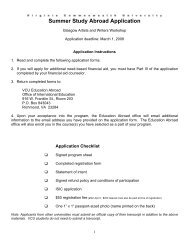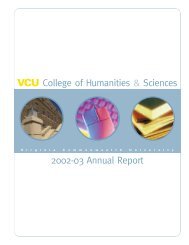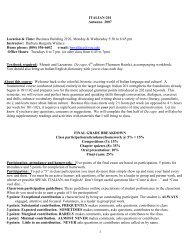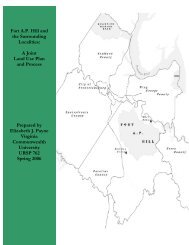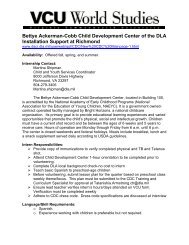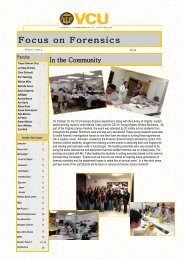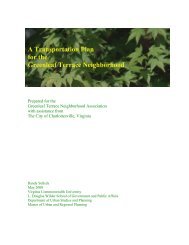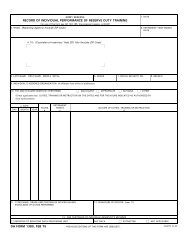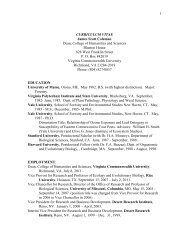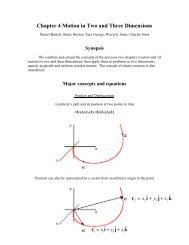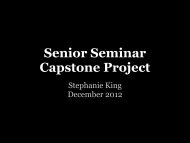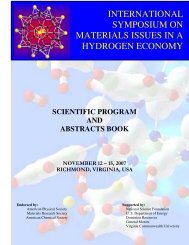Focus on Forensics - College of Humanities and Sciences - Virginia ...
Focus on Forensics - College of Humanities and Sciences - Virginia ...
Focus on Forensics - College of Humanities and Sciences - Virginia ...
You also want an ePaper? Increase the reach of your titles
YUMPU automatically turns print PDFs into web optimized ePapers that Google loves.
<str<strong>on</strong>g>Focus</str<strong>on</strong>g> <strong>on</strong> <strong>Forensics</strong><br />
Volume 11, Issue 1<br />
Faculty<br />
Tracey Daws<strong>on</strong><br />
Cruz<br />
Lyndsay Durham<br />
Chris Ehrhardt<br />
Eric Hazelrigg<br />
Excellence in our Graduates<br />
Outst<strong>and</strong>ing<br />
Graduate<br />
Joseph Ring<br />
Fall<br />
Marilyn Miller<br />
Michelle Peace<br />
Sarah Seashols<br />
Affiliate:<br />
Ann Davis<br />
Pete Mar<strong>on</strong>e<br />
Al Poklis<br />
Robert Steiner<br />
Carl Wolf<br />
Inside this issue:<br />
GRADUATION 2<br />
SPOTLIGHTS<br />
UNDERGRAD 3<br />
GRAD 4<br />
FSSC 4<br />
INTERNATIONAL 5<br />
MILITARY 6<br />
SPORT 6<br />
Outst<strong>and</strong>ing<br />
Undergraduate<br />
Samantha Boyd<br />
Matthew Goldstein<br />
May<br />
2012<br />
Leadership <strong>and</strong><br />
Service Awards<br />
Graduate Students<br />
Jessica Barker<br />
Vaibhav “Web” Bist<br />
Alex<strong>and</strong>er Jacobs<br />
Crystal Munger<br />
Laura Caitlin Oliver<br />
Joseph Ring<br />
Katherine van den<br />
Heever<br />
Undergraduate Students<br />
Kent Aje<br />
Jessica Combs<br />
Matthew Goldstein<br />
Sarita Schultz<br />
Sarah Willis<br />
Academic Achievement<br />
Awards<br />
(Cumulative GPA <strong>of</strong> 3.85 or<br />
higher)<br />
Graduate Students<br />
Jessica Barker<br />
Shann<strong>on</strong> Cassatt<br />
Jeremy M<strong>on</strong>kres<br />
Crystal Munger<br />
Joseph Ring<br />
Maria Saeed<br />
Katherine van den Heever<br />
ALUMNI 7<br />
NEW FACULTY 8<br />
INSTRUMENTATION 8<br />
Undergraduate Students<br />
Samantha Boyd<br />
Matthew Goldstein<br />
Ian O’Keefe<br />
WORKSHOP 9<br />
RENOVATION 10
Page 2 F ocus <strong>on</strong> Fo rensics Volume 11, Issue 1<br />
Undergraduate Class <strong>of</strong> 2012<br />
Ali Abed<br />
Kent Aje<br />
Mohamed Alabduljabbar<br />
K<strong>and</strong>ice Alex<strong>and</strong>er<br />
Astrid Aniwa<br />
Carla Bacchus<br />
Mohamead Bakir<br />
Noel Basma<br />
K'Sh<strong>on</strong>da Bishop-Crump<br />
Samantha Boyd<br />
Ra-Shaunti Budgess<br />
Heather Chapman<br />
Jessica Combs<br />
Sean Cr<strong>on</strong>in<br />
Marjan Darab<br />
Christina Ferrer<br />
Matthew Goldstein<br />
Graduate<br />
Anna Greer<br />
Sabih Haq<br />
Michelle Harper<br />
Sadia Hassan<br />
Christina Hayes<br />
Kinjalba Jadeja<br />
Am<strong>and</strong>a Jennings<br />
Kathryn Johns<strong>on</strong><br />
Navneet Kaur<br />
Victoria Knopik<br />
Marlea Lee<br />
Anna Le<strong>on</strong>e<br />
Kate Lepire<br />
Ishaq Mallik<br />
Cher<strong>on</strong><br />
Maxwell<br />
Katherine<br />
McD<strong>on</strong>ald<br />
Class <strong>of</strong> 2012<br />
Roberto Mejia<br />
Am<strong>and</strong>a Michael<br />
Crystal Minwegen<br />
Horatio Nguyen<br />
Justin Nguyen<br />
Ian O'Keefe<br />
James Phan<br />
Lyndsi Porto<br />
Sarita Schultz<br />
Laura Schweinhart<br />
Whitney Simps<strong>on</strong><br />
Rose Villanueva<br />
Kaitlin Warringt<strong>on</strong><br />
Rykia Williams<br />
Sarah Willis<br />
Jessica Barker<br />
Jennifer Bartman<br />
Samantha Berghorn<br />
Web Bist<br />
Shann<strong>on</strong> Cassatt<br />
Ashley Goldstein<br />
Tyler Grissom<br />
Travis Harris<br />
Alex Jacobs<br />
Grace Jang<br />
Hillary Krause<br />
Jeremy M<strong>on</strong>kres<br />
Crystal Munger<br />
Caitlin Oliver<br />
Andrea Phares<br />
Joseph Ring<br />
Maria Saeed<br />
Kate van den Heever<br />
Christopher Witt
Volume 11, Issue 1<br />
F ocus <strong>on</strong> Fo rensics<br />
Page 3<br />
Undergraduate Spotlight: Sammy Boyd<br />
I, al<strong>on</strong>g with Pr<strong>of</strong>essor Bertino, Pr<strong>of</strong>essor Seashols, <strong>and</strong> Jacob Huffstickler have been researching<br />
the applicati<strong>on</strong>s <strong>of</strong> Raman Spectroscopy to body fluid analysis – specifically blood –<br />
for the past three years. Saying (or writing) that sounds incredibly fancy. I'm almost sad to<br />
demystify our work, but the reality is that it is not too difficult to underst<strong>and</strong> what we have<br />
d<strong>on</strong>e, <strong>on</strong>ce you underst<strong>and</strong> how the Raman works. Basically what happens is that a laser is<br />
aimed at a sample. When the laser is focused <strong>on</strong> the sample, an interacti<strong>on</strong> happens which<br />
vibrates <strong>and</strong> rotates the molecules comprising the sample, raising their electr<strong>on</strong>s to an excited<br />
state. When the electr<strong>on</strong>s return to a lower energy state, they return the energy that<br />
they initially received from the laser; light is scattered. The scattered wavelengths pass<br />
through some filters so that what is left is <strong>on</strong>ly the light that has been inelastically scattered –<br />
it's a different wavelength from the laser. Those inelastically scattered wavelengths are interpreted<br />
as peaks al<strong>on</strong>g a number line <strong>and</strong> those peaks,<br />
like with IR spectroscopy, are indicative <strong>of</strong> chemical b<strong>on</strong>ds<br />
<strong>and</strong> thus, the chemical compositi<strong>on</strong> <strong>of</strong> the sample. This<br />
allows us to take unknown items, analyze them, <strong>and</strong> determine<br />
their identity based <strong>on</strong> the spectras that are produced.<br />
What has been discovered with our work so far is that the<br />
spectra <strong>of</strong> blood has the same peaks between people. We<br />
know that dry blood looks a little bit different from wet<br />
blood, that sometimes you can get a reading <strong>of</strong> blood <strong>on</strong><br />
different substrates but the substrates that fluoresce a lot<br />
(denim, cott<strong>on</strong>, etc...) make it difficult to produce a spectra<br />
<strong>of</strong> blood. We know that we can rec<strong>on</strong>stitute blood to recover that<br />
Natural<br />
spectra,<br />
curiosity<br />
but<br />
<strong>and</strong><br />
the<br />
doing<br />
downfall<br />
her research<br />
is a diluti<strong>on</strong> limitati<strong>on</strong> to<br />
to<br />
that (aside from the fact that it damages the sample) is that there<br />
what the Raman can “read”. To compensate for that, we know that Surfaced Enhanced Raman<br />
Spectroscopy can be employed to enhance the signal. With this, an electromagnetic field is<br />
c<strong>on</strong>centrated around the sample to produce an enhancement. This allows us to go from a diluti<strong>on</strong><br />
limitati<strong>on</strong> <strong>of</strong> 1:250 to 1:100,000. We also know that a menial<br />
amount <strong>of</strong> DNA is degraded through this process <strong>and</strong> that<br />
items which comm<strong>on</strong>ly produce false positives for presumptive<br />
tests for blood have spectras that are distinct from blood.<br />
I've never c<strong>on</strong>sidered myself to be a particularly innovative or<br />
an incredibly intelligent pers<strong>on</strong>. I'll grant myself hardworking<br />
<strong>and</strong> curious – I always have to underst<strong>and</strong> the why <strong>and</strong> the<br />
how...I do my research. I can h<strong>on</strong>estly say that I never envisi<strong>on</strong>ed<br />
that I would be doing any sort <strong>of</strong> research in school; that<br />
was for clinicians with white coats <strong>and</strong> beakers. When I started<br />
doing research I could barely work a microscope. But now I'm<br />
graduated with three years <strong>of</strong> research <strong>and</strong> a few publicati<strong>on</strong>s<br />
<strong>and</strong> presentati<strong>on</strong>s under my belt. I still d<strong>on</strong>'t think <strong>of</strong> myself as<br />
innovative or very intelligent; my experiences are a result <strong>of</strong> an<br />
incredible amount <strong>of</strong> faith <strong>on</strong> the part <strong>of</strong> my pr<strong>of</strong>essors, a lot <strong>of</strong><br />
luck <strong>and</strong> being at the right place at the right time, <strong>and</strong> because<br />
(as I said before) I am a naturally curious pers<strong>on</strong>. And I know<br />
that if I can wind up doing what I did, any<strong>on</strong>e can too. Be outgoing.<br />
Get to know your pr<strong>of</strong>essors. Show a willingness to try<br />
new things <strong>and</strong> most importantly, do your research.
Volume 11, Issue 1<br />
F ocus <strong>on</strong> Fo rensics<br />
Page 4<br />
Graduate Spotlight Alex Jacobs<br />
Greetings! I’m Alex Jacobs, a graduate <strong>of</strong> the<br />
class <strong>of</strong> 2012 Forensic Science Master’s<br />
Program at VCU. While working <strong>on</strong> my degree,<br />
I completed several research projects. My<br />
directed research project was the Analysis<br />
<strong>of</strong> Natural Testoster<strong>on</strong>e Boosters for the<br />
Presence <strong>of</strong> Steroids<br />
though the use <strong>of</strong> the<br />
Accu-TOF DART under<br />
the mentorship <strong>of</strong><br />
Robert Steiner at the<br />
<strong>Virginia</strong> Department <strong>of</strong><br />
Forensic Science. The<br />
goal <strong>of</strong> the project was<br />
to develop a screening<br />
method for these supplements<br />
to determine if<br />
minute levels <strong>of</strong> steroids<br />
could be detected.<br />
However, because <strong>of</strong><br />
all the other organic<br />
material in these products,<br />
low levels were<br />
unable to be detected reliably. I c<strong>on</strong>tinued<br />
to work under Mr. Steiner, working <strong>on</strong> detecting<br />
the chromophore produced by the<br />
Duquenois-Levine test for tetrahydrocannabinol.<br />
This research sought to detect the chromophore<br />
in a marijuana sample, as the structure <strong>of</strong> the<br />
chromophore had been previously determined.<br />
My work with the test also helped to derive a<br />
change in the formula that allowed older samples<br />
to produce results similar to that <strong>of</strong> a fresh<br />
sample. This research was presented at the 2012<br />
Mid-Atlantic Associati<strong>on</strong> <strong>of</strong> Forensic Scientists<br />
meeting, where it was well-received. This fall, I<br />
will be attending Indiana University to pursue a<br />
doctoral degree in Analytical Chemistry. I will begin<br />
research with the Clemmer Group starting<br />
this June.<br />
Completing the VCU Forensic Science Master’s<br />
Program allowed me to discover my love for<br />
research <strong>and</strong> the development <strong>of</strong> new ideas to<br />
solve a problem. Before starting the master’s<br />
program, I was unsure what my true interests<br />
were. Through the program <strong>and</strong> by working with<br />
Mr. Steiner, I found I was more interested in<br />
research than performing casework. Ultimately,<br />
this is what led me to decide to c<strong>on</strong>tinue my<br />
educati<strong>on</strong> <strong>and</strong> pursue a doctorate.<br />
Forensic Science Student Club<br />
Welcome to a br<strong>and</strong> new semester for the Forensic Science Student Club!<br />
We are excited <strong>and</strong> ready to welcome new members to our club. The club participates<br />
in a wide variety <strong>of</strong> trips, speaking engagements, VCU special events<br />
<strong>and</strong> open houses. Our most notable event is our annual Murder Mystery Dinner<br />
Theater which last semester had its biggest turnout <strong>of</strong> 110 guests c<strong>on</strong>sisting <strong>of</strong><br />
students, parents, <strong>and</strong> faculty!<br />
Each semester the club engages in <strong>of</strong>f-campus learning opportunities<br />
such as a tour <strong>of</strong> the Office <strong>of</strong> the Chief Medical Examiner, Domini<strong>on</strong><br />
Shooting Range <strong>and</strong> a trip to the Crime <strong>and</strong> Punishment<br />
Museum in Washingt<strong>on</strong> D.C. The club hosts speakers such as<br />
Mary Maguire who is a Federal Public Defender <strong>and</strong> former Chief<br />
Medical Examiner, Dr. Marcella Fierro. The club also participates<br />
in various volunteer opportunities throughout the semester like<br />
the campus blood drives, SOVO fair, open houses, <strong>and</strong> Relay for<br />
Life.<br />
This semester kicked <strong>of</strong>f with a club meeting <strong>on</strong> Thursday,<br />
August 30 th in M<strong>on</strong>roe Park where we played games, had<br />
prizes <strong>and</strong> provided great informati<strong>on</strong> about the club, its activities<br />
<strong>and</strong> the <strong>of</strong>ficers. We look forward to having an amazing semester<br />
with you <strong>and</strong> if you have any questi<strong>on</strong>s, comments or c<strong>on</strong>cerns please c<strong>on</strong>tact Megan Tabor<br />
at tabormn@vcu.edu or you can reach us at the Forensic Science Student Club’s Facebook page.
Volume 11, Issue 1<br />
F ocus <strong>on</strong> Fo rensics<br />
Page 5<br />
Internati<strong>on</strong>al Spotlight Jarah Al-Thafiri<br />
My name is Jarah Al-Thafiri, a citizen from Kuwait, a small country in the Middle East, which has an estimated<br />
populati<strong>on</strong> <strong>of</strong> three milli<strong>on</strong> today. Up<strong>on</strong> finishing high school, I had no clue which major to<br />
choose until there was an announcement that the ministry <strong>of</strong> interior opened up its doors for applicants<br />
wishing to join the military. The program <strong>of</strong>fered a scholarship in forensic science. It sparked my interest<br />
when I read “forensic science” in the ad, being a major fan “CSI” <strong>and</strong> a major geek when it came to<br />
chemistry <strong>and</strong> biology. After passing the required examinati<strong>on</strong>s <strong>and</strong> getting accepted into the program, I<br />
was told by <strong>of</strong>ficials that it was being taught in the United States, at <strong>Virginia</strong> Comm<strong>on</strong>wealth University<br />
to be specific. I had no clue where <strong>Virginia</strong> even was <strong>on</strong> a map!<br />
Coming to VCU was a culture shock for me. I had never traveled al<strong>on</strong>e <strong>and</strong> so far, making friends from<br />
other countries <strong>and</strong> other nati<strong>on</strong>alities, <strong>and</strong> looking at things from a different perspective. It taught me<br />
how to take charge <strong>and</strong> be resp<strong>on</strong>sible. The excitement <strong>and</strong> rush all began when I took my first forensic<br />
based class, a survey <strong>of</strong> this unique major, ranging from crime scene <strong>and</strong> search, firearms <strong>and</strong> ballistics,<br />
serology, toxicology, entomology <strong>and</strong> other different areas <strong>of</strong> the study. As I took more core classes, I<br />
found myself more attracted to the field <strong>and</strong> thankful that I chose to embark <strong>on</strong> this great journey.<br />
After graduati<strong>on</strong> <strong>and</strong> coming back home to start work, I knew<br />
that there would be a difference in the applicati<strong>on</strong> <strong>of</strong> the scientific<br />
techniques that we’ve practiced <strong>and</strong> studied back in the<br />
states. Let’s start <strong>on</strong> how our work system functi<strong>on</strong>s here:<br />
There are six districts in Kuwait, served by the Department <strong>of</strong><br />
Criminal Evidence which has the following secti<strong>on</strong>s: crime<br />
scene (where I work), medical examinati<strong>on</strong>, administrati<strong>on</strong>,<br />
criminal photography, fingerprint archive <strong>and</strong> the main laboratories<br />
. Since I work in the crime scene <strong>and</strong> search secti<strong>on</strong> in<br />
<strong>on</strong>e district, I’m not involved in lab work. Our main task is to<br />
travel to the scene <strong>of</strong> the crime, take notes <strong>and</strong> photographic<br />
evidence, <strong>and</strong> collect any valuable piece <strong>of</strong> evidence. I’m glad<br />
that I get to work in that particular secti<strong>on</strong> because everything<br />
starts at the crime scene. I get to interact with important <strong>of</strong>ficials<br />
at the scene, such as the DA, medical examiner, witnesses <strong>and</strong> various police <strong>of</strong>ficials. As a crime<br />
scene investigator in the police force, I take c<strong>on</strong>trol at the scene, making sure no evidence goes unnoticed<br />
or is tampered with. My job c<strong>on</strong>sists <strong>of</strong> a 24 hour shift, where three other forensic practiti<strong>on</strong>ers<br />
<strong>and</strong> I split the caseload <strong>of</strong> the day. In the district in which I work, most <strong>of</strong> the cases involve house burglaries,<br />
car thefts <strong>and</strong> natural death but we do get the occasi<strong>on</strong>al suicide, murder, ars<strong>on</strong> <strong>and</strong> attempted<br />
assaults. The job also <strong>of</strong>fers seminars <strong>on</strong> advancements in the field such as teaching <strong>and</strong> using three<br />
dimensi<strong>on</strong>al photography, seminars in other departments such as Kuwait’s Investigati<strong>on</strong> Bureau <strong>and</strong> at<br />
times, overseas in the States <strong>and</strong> Engl<strong>and</strong>.<br />
The <strong>on</strong>ly negative thing about the job is that our department<br />
does not close the case but it is the bureau that closes it. We<br />
are the <strong>on</strong>es who start the work at the scene, acquire the<br />
evidence, send samples to the lab <strong>and</strong> receive the results<br />
that help the DA <strong>and</strong> investigati<strong>on</strong> team catch the assailants.<br />
When it comes to the future, I would like to branch out further<br />
in the field, earn a master’s degree <strong>and</strong> a PhD in physical<br />
evidence <strong>and</strong> maybe teach the future police <strong>of</strong>ficers who, like<br />
me, choose this as a career. I would also like to study more<br />
about criminology <strong>and</strong> its various aspects <strong>of</strong> study <strong>and</strong> try to<br />
apply it back home. I would love to get the opportunity to<br />
work <strong>and</strong> practice the field in another country to compare<br />
notes with them <strong>and</strong> improve my knowledge in the field.
Volume 11, Issue 1<br />
F ocus <strong>on</strong> Fo rensics<br />
Page 6<br />
Military Spotlight<br />
Jillian Merritt<br />
I originally looked at the Navy as a way<br />
to pay for Medical School. As a Forensic<br />
Science major I had a lot <strong>of</strong> exposure to<br />
the biological sciences <strong>and</strong> when I took<br />
Forensic Medicine it made me want to<br />
pursue a career as a medical examiner.<br />
However, the more I thought about it, the<br />
more unsure I was about my decisi<strong>on</strong> to<br />
attend medical school. I decided to see<br />
what else the Navy had to <strong>of</strong>fer so I<br />
spent hours going over the different<br />
types <strong>of</strong> jobs they had, the commitment<br />
you had to make, <strong>and</strong> the applicati<strong>on</strong><br />
process. I found a field that I thought was<br />
particularly interesting so I decided I<br />
wanted to apply. After a grueling applicati<strong>on</strong><br />
process I found out I was selected for my<br />
first choice field- Informati<strong>on</strong> Warfare. I went<br />
to Officer C<strong>and</strong>idate School (OCS), got my<br />
commissi<strong>on</strong>ing <strong>on</strong> June 3, 2011 <strong>and</strong> then went<br />
to Pensacola for my Informati<strong>on</strong> Warfare<br />
Basic Course. I am now stati<strong>on</strong>ed in Hawaii<br />
for 3 years! I am the <strong>on</strong>ly pers<strong>on</strong> from my<br />
OCS class <strong>and</strong> at my new comm<strong>and</strong> with a<br />
Forensic Science degree <strong>and</strong> I am also the<br />
<strong>on</strong>ly Informati<strong>on</strong> Warfare designator from my<br />
OCS class. I believe many <strong>of</strong> the skills I<br />
learned in the Forensic Science program have<br />
helped me so far in my Naval Career. I am<br />
now a Divisi<strong>on</strong> Officer <strong>and</strong> lead two 24-hour<br />
watch teams <strong>and</strong> the informati<strong>on</strong> technology<br />
service desk. I have been Commissi<strong>on</strong>ed in<br />
the Navy for a little over a year now <strong>and</strong> I<br />
love every minute <strong>of</strong> it. It am always learning<br />
something new <strong>and</strong> finding ways to improve<br />
my leadership. People<br />
always ask me what I<br />
majored in <strong>and</strong> when I<br />
tell them "Forensic<br />
Science, Biology Track<br />
with a minor in<br />
Chemistry" they look<br />
c<strong>on</strong>fused. I tell them, it<br />
may not be directly<br />
related to what I do<br />
now, but it definitely<br />
gave me a solid foundati<strong>on</strong><br />
<strong>and</strong> I feel like I<br />
can go anywhere with<br />
my unique educati<strong>on</strong>al<br />
background.<br />
Sport Spotlight<br />
Luke Thomas<strong>on</strong><br />
I figured out <strong>on</strong>e day the<br />
percentage <strong>of</strong> the student<br />
body that is athletically involved.<br />
It is around .05 %. It’<br />
s kind <strong>of</strong> crazy to think. In<br />
high school, what was the<br />
percentage? Thirty percent,<br />
maybe 40%? Being <strong>on</strong><br />
the track team keeps me in<br />
line when it comes to school.<br />
As coach always reminds<br />
us, school is always first. If<br />
there is a test or a project<br />
that needs to be d<strong>on</strong>e, we<br />
can be excused from practice.<br />
It’s better to miss <strong>on</strong>e<br />
practice than to fail <strong>and</strong> be <strong>on</strong> athletic suspensi<strong>on</strong><br />
the whole next semester. Being <strong>on</strong><br />
the track team means I am always busy.<br />
Being always busy means that time is what<br />
I value most. When things start to get cut<br />
short, it is about a guarantee that amount <strong>of</strong><br />
hours to sleep will decrease. To most people,<br />
6 hours <strong>of</strong> sleep means that the next<br />
day will be a l<strong>on</strong>g <strong>on</strong>e. For me, 6 hours is a<br />
blessing. Most people (even athletes) can<br />
usually catch up with their sleep <strong>on</strong> the<br />
weekends. When in seas<strong>on</strong>, (all sec<strong>on</strong>d<br />
semester) there is a track meet almost<br />
every Saturday somewhere al<strong>on</strong>g the east<br />
coast. It could be as close as George Mas<strong>on</strong><br />
or it could be as far as University <strong>of</strong> South<br />
Florida. That varies from getting up around<br />
5 to be at a local meet (Mas<strong>on</strong>) or leaving<br />
late <strong>on</strong> a Thursday for a meet that entails a<br />
l<strong>on</strong>g bus ride or a flight out <strong>of</strong> RIC. I have<br />
loved every minute <strong>of</strong> being <strong>on</strong> the team<br />
here at VCU. I have met some great people<br />
al<strong>on</strong>g the way. I have also had some<br />
great less<strong>on</strong>s taught <strong>on</strong> <strong>and</strong> <strong>of</strong>f the field. I<br />
love sports <strong>and</strong> I will truly miss them after I<br />
graduate.<br />
For now, I work part time at Health Diagnostic<br />
Lab in downtown Richm<strong>on</strong>d where I<br />
plan <strong>on</strong> going full time after completi<strong>on</strong> <strong>of</strong><br />
my undergraduate degree (spring 2013). I<br />
will work there while completing an MBA.<br />
My ultimate goal is combine my undergraduate<br />
knowledge <strong>of</strong> science with the<br />
business knowledge <strong>of</strong> the MBA. That way,<br />
I can help run a company from not <strong>on</strong>ly the<br />
science side but the business side too.
Page 7 F ocus <strong>on</strong> Fo rensics Volume 11, Issue 1<br />
Alumni Spotlight Web Bist & Caitlin Oliver<br />
It was a mere four weeks <strong>on</strong><br />
the lavish campus <strong>of</strong> InfoSys<br />
located in Mysore, India. We<br />
began our trip with a 24 hour<br />
plane ride, having <strong>on</strong>ly a<br />
week to adjust to the tenhour<br />
time difference. With<br />
graduate school just finishing,<br />
we quickly had to apply our<br />
knowledge into a three-week<br />
crash course <strong>on</strong> the basics <strong>of</strong><br />
forensic science. It didn’t become<br />
real until we met the<br />
35 children we would be<br />
teaching. Each <strong>of</strong> our classes<br />
c<strong>on</strong>tained 17-18 seventh<br />
st<strong>and</strong>ard kids who tested in<br />
the 99 th percentile in the entire<br />
country <strong>of</strong> India. After<br />
the first day, it was apparent<br />
how brilliant these kids really<br />
were. Their enthusiasm kept<br />
us going night after night,<br />
adapting our less<strong>on</strong> plans to<br />
challenge them in all areas <strong>of</strong><br />
forensic science. This included<br />
us having to research <strong>and</strong><br />
become more familiar with<br />
topics that were <strong>on</strong>ly touched<br />
up<strong>on</strong> in our studies outside<br />
our c<strong>on</strong>centrati<strong>on</strong>. During the<br />
first two weeks, we provided<br />
the students with the basic<br />
skill set <strong>of</strong> a forensic scientist.<br />
We were excited the<br />
next week when they were<br />
able to apply these skills to a<br />
mock crime we created. We<br />
incorporated everything from<br />
DNA to h<strong>and</strong>writing in these<br />
mock crime scenes so the<br />
students would need to bring<br />
their best to be successful.<br />
Although the teaching kept<br />
us busy six <strong>of</strong> the seven days<br />
in the week, we got to explore<br />
outside the campus.<br />
The highlight <strong>of</strong> our adventures in<br />
the city was visiting the largest<br />
palace in India, the Mysore palace.<br />
We were able to go inside<br />
<strong>and</strong> learn about the history <strong>and</strong><br />
culture <strong>of</strong> the regi<strong>on</strong>. Despite not<br />
having any time to breathe<br />
between school <strong>and</strong> India, the<br />
chance to teach these bright kids<br />
has been an unforgettable<br />
experience. We’d like to thank<br />
Dr. Marilyn Miller for providing<br />
us with this <strong>on</strong>ce-in-a-lifetime<br />
opportunity.<br />
Alumni Associati<strong>on</strong>: Join Now<br />
GOLD (Graduates <strong>of</strong> the Last Decade)<br />
The VCU Alumni Associati<strong>on</strong> <strong>of</strong>fers GOLD<br />
special membership pricing, (<strong>on</strong>ly $25) If your<br />
first degree from VCU was earned in 2002 or<br />
later you qualify. Benefits <strong>of</strong> membership include<br />
CareerBeam, <strong>on</strong>line journals access, exp<strong>and</strong>ed<br />
access to the <strong>on</strong>line alumni directory <strong>and</strong> many<br />
discounts. In additi<strong>on</strong>, look for special<br />
GOLD events.<br />
The goal <strong>of</strong> STAT is to facilitate interacti<strong>on</strong><br />
between students <strong>and</strong> alumni <strong>and</strong> to enhance the<br />
student experience by providing opportunities<br />
STAT (Students Today Alumni Tomorrow)<br />
that strengthen lifel<strong>on</strong>g loyalty to VCU. STAT<br />
provides unique benefits including networking<br />
with alumni, c<strong>on</strong>necting with other VCU students,<br />
STAT T-shirt to wear <strong>on</strong> T-shirt days to get<br />
even more free stuff, BEAT shirts to show your<br />
Ram Pride at athletic events & complimentary<br />
items <strong>on</strong> Spirit Day. We will have events <strong>and</strong><br />
programs all year l<strong>on</strong>g with free goodies for<br />
STAT members <strong>on</strong>ly. Annual membership is <strong>on</strong>ly<br />
$15 per school year. You can also join STAT as a<br />
four-year member for <strong>on</strong>ly $50 .
Volume 11, Issue 1<br />
F ocus <strong>on</strong> Fo rensics<br />
Page 8<br />
Instrumentati<strong>on</strong>: Leica Geosystems' ScanStati<strong>on</strong><br />
Thanks to the generous support<br />
<strong>of</strong> the Provost’s Office<br />
<strong>and</strong> the Dean’s Office <strong>of</strong> the<br />
<strong>College</strong> <strong>of</strong> <strong>Humanities</strong> <strong>and</strong><br />
<strong>Sciences</strong>, the Department <strong>of</strong><br />
Forensic Science has recently<br />
purchased a Leica Geosystems’<br />
ScanStati<strong>on</strong>-10 3D<br />
laser scanner. The ScanStati<strong>on</strong><br />
is a versatile <strong>and</strong> easy-to<br />
-use 3D laser scanning system<br />
which enables users to panoramically<br />
photograph <strong>and</strong><br />
then laser scan (measure) a<br />
scene with an extraordinary<br />
level <strong>of</strong> speed, accuracy <strong>and</strong><br />
completeness. The informati<strong>on</strong><br />
gathered can be used to generate<br />
up to seven high-value<br />
3-D rapid resp<strong>on</strong>se products<br />
within minutes <strong>of</strong> scanning for<br />
briefings <strong>and</strong> to provide detectives<br />
with detailed informati<strong>on</strong><br />
about the crime scene <strong>and</strong> the<br />
physical evidence. In the courtroom,<br />
Leica Geosystems' laser scanning<br />
data allows prosecutors to place<br />
the jury at the scene. Leica Geosystems'<br />
ScanStati<strong>on</strong> technology has<br />
been adopted by thous<strong>and</strong>s <strong>of</strong><br />
forensic laboratories <strong>and</strong> law enforcement<br />
agencies around the<br />
world. This documentati<strong>on</strong> instrument<br />
is <strong>of</strong> interest to a variety<br />
<strong>of</strong> criminal justice system<br />
pr<strong>of</strong>essi<strong>on</strong>als: Homicide Detectives,<br />
Prosecutors, Homel<strong>and</strong> Security<br />
Officials, Crime Scene Investigators,<br />
Forensic Scientists,<br />
Special Weap<strong>on</strong>s <strong>and</strong> Tactics Pers<strong>on</strong>nel,<br />
Cor<strong>on</strong>er/Medical Examiners,<br />
EOD Technicians, <strong>and</strong> Shooting Rec<strong>on</strong>structi<strong>on</strong>ists.<br />
The Department <strong>of</strong> Forensic Science<br />
will be introducing this laser scanner<br />
in the basic crime scene investigati<strong>on</strong><br />
course, FRSC 309 <strong>and</strong> FRSC<br />
Leica Trainer working with TA<br />
Erica Dolak.<br />
565. Intensive student use is anticipated<br />
for the FRSC 566 Advanced<br />
Crime Scene Investigati<strong>on</strong><br />
course for Spring 2014. Several<br />
students are ready to begin Independent<br />
Study projects utilizing<br />
the Scan Stati<strong>on</strong> in various crime<br />
scene scenarios such crime<br />
scenes rec<strong>on</strong>structi<strong>on</strong> with bloodstain<br />
patterns, shooting rec<strong>on</strong>structi<strong>on</strong>s,<br />
accident <strong>and</strong> fire<br />
scenes. These independent study<br />
projects will utilize the 3D laser<br />
scanners’ ability to provide a<br />
highly accurate, systematic approach.<br />
Meet Chris Ehrhardt, Ph.D.<br />
Dr. Ehrhardt holds a B.S. degree<br />
in Molecular <strong>and</strong> Cellular Biology<br />
from the University <strong>of</strong> C<strong>on</strong>necticut<br />
at Storrs. He then began his<br />
graduate work at UC-Santa Barbara<br />
in the Department <strong>of</strong> Earth<br />
<strong>and</strong> Envir<strong>on</strong>mental <strong>Sciences</strong><br />
where he c<strong>on</strong>ducted research <strong>on</strong><br />
the genetic <strong>and</strong> chemical signatures<br />
<strong>of</strong> marine hydrothermal microorganisms.<br />
After completing his PhD in 2007, Dr.<br />
Ehrhardt worked as a postdoctoral researcher at the<br />
Counterterrorism <strong>and</strong> Forensic Science Research Unit<br />
<strong>of</strong> the FBI in Quantico VA. While at the FBI, he focused<br />
<strong>on</strong> forensic signatures <strong>of</strong> Bacillus cereus<br />
spores, specifically how fatty acid methyl ester pr<strong>of</strong>iles<br />
<strong>of</strong> spores can be used to determine the source <strong>of</strong><br />
illicitly-produced microorganisms. He also participated<br />
in a number <strong>of</strong> other research projects while at<br />
the FBI including protein pr<strong>of</strong>iling <strong>of</strong> spores, bacterial<br />
hydrophobicity determinati<strong>on</strong>s, <strong>and</strong> testing <strong>of</strong> forensic<br />
light sources <strong>on</strong> biological evidence.<br />
After the FBI, Dr. Ehrhardt worked in the Trace<br />
Chemistry <strong>and</strong> Signature Science Group at Pacific<br />
Northwest Nati<strong>on</strong>al Laboratory (PNNL) in Richl<strong>and</strong>,<br />
WA. There he primarily worked <strong>on</strong> developing forensic<br />
signatures for Yersinia pestis <strong>and</strong> Bacillus anthracis<br />
but also helped refine multivariate frameworks for distinguishing<br />
castor beans processed with different<br />
methods.<br />
At VCU, Dr. Ehrhardt’s main interests are the forensics<br />
associated with pathogen m<strong>on</strong>itoring <strong>and</strong> specifically<br />
how biochemical signatures associated with a<br />
bacterial cell can be used to distinguish the occurrences<br />
<strong>of</strong> ‘natural’ from man-made organisms. He is<br />
working <strong>on</strong> new biosignature systems (e.g. protein <strong>and</strong><br />
lipid pr<strong>of</strong>iles) for organism identificati<strong>on</strong> in complex<br />
matrices such as soil, air, <strong>and</strong> envir<strong>on</strong>mental water<br />
supplies. In additi<strong>on</strong>, Dr. Ehrhardt is intensely interested<br />
in multivariate statistical methods to process <strong>and</strong><br />
interpret the <strong>of</strong>ten complex orthog<strong>on</strong>al data generated<br />
from his projects.<br />
Dr. Ehrhardt c<strong>on</strong>tinues to collaborate with the FBI <strong>and</strong><br />
PNNL as well as several other university <strong>and</strong> private<br />
laboratories. He has published several manuscripts <strong>on</strong><br />
envir<strong>on</strong>mental signatures <strong>of</strong> microorganisms <strong>and</strong> the<br />
forensic applicati<strong>on</strong>s <strong>of</strong> various microbial pr<strong>of</strong>iling<br />
techniques.
Volume 11, Issue 1<br />
F ocus <strong>on</strong> Fo rensics<br />
Page 9<br />
Mass Fatalities Workshop<br />
This past semester at VCU, forensic<br />
science students had a w<strong>on</strong>derful opportunity<br />
to attend a mass fatality workshop cosp<strong>on</strong>sored<br />
by SNA Internati<strong>on</strong>al, the <strong>Virginia</strong><br />
Office <strong>of</strong> the Chief Medical Examiner, <strong>and</strong> the<br />
VCU Forensic Science Department. SNA Internati<strong>on</strong>al<br />
is a c<strong>on</strong>sulting firm run by Am<strong>and</strong>a<br />
Sozer, Stephen Niezgoda, <strong>and</strong> Arbie Goings.<br />
Located in Washingt<strong>on</strong>, D.C., the missi<strong>on</strong> <strong>of</strong><br />
SNA Internati<strong>on</strong>al is to <strong>of</strong>fer expert advice in<br />
the areas <strong>of</strong> mass fatality planning <strong>and</strong> resp<strong>on</strong>se,<br />
forensic science c<strong>on</strong>sulting, <strong>and</strong> informati<strong>on</strong><br />
technology tools. In the words <strong>of</strong> Dr. Am<strong>and</strong>a<br />
Sozer, “identificati<strong>on</strong> <strong>of</strong> human remains after a<br />
mass fatality is probably the ultimate forensic<br />
case.”<br />
The workshop <strong>of</strong>fered at VCU was open<br />
to forensic science pr<strong>of</strong>essi<strong>on</strong>als <strong>and</strong> emergency<br />
resp<strong>on</strong>ders from a variety <strong>of</strong> agencies across<br />
<strong>Virginia</strong>. Participants included pers<strong>on</strong>nel from<br />
the <strong>Virginia</strong> Department <strong>of</strong> Forensic Science,<br />
the <strong>Virginia</strong> Department <strong>of</strong> Emergency<br />
Management, Bode Technology, the VCU<br />
Police Department, <strong>and</strong> pr<strong>of</strong>essors <strong>and</strong><br />
students from <strong>Virginia</strong> Comm<strong>on</strong>wealth University.<br />
Training was provided related to underst<strong>and</strong>ing<br />
the challenges <strong>of</strong> a mass fatality event <strong>and</strong><br />
in the areas <strong>of</strong> body recovery, mortuary operati<strong>on</strong>s,<br />
identificati<strong>on</strong> <strong>of</strong> human remains,<br />
family assistance, body release, <strong>and</strong> public<br />
informati<strong>on</strong>. Breakout sessi<strong>on</strong>s were<br />
given <strong>on</strong> Forensic Identificati<strong>on</strong> <strong>of</strong> Human<br />
Remains, Body Recovery, Family Assistance<br />
Operati<strong>on</strong>s, <strong>and</strong> Data Management.<br />
The workshop culminated in an interactive<br />
tabletop exercise that allowed participants<br />
to discuss how they would resp<strong>on</strong>d<br />
to a hypothetical mass fatality occurring<br />
at the Siegel Center at VCU.<br />
VCU forensic science students<br />
who wanted to attend the workshop<br />
prepared by taking FRSC 591 Topics in<br />
Forensic Science: Getting Prepared –<br />
Mass Fatality Resp<strong>on</strong>se Training. This<br />
class was comprised <strong>of</strong> a mixture <strong>of</strong><br />
graduate <strong>and</strong> undergraduate students who<br />
had an interest in learning about mass<br />
fatality preparedness <strong>and</strong> resp<strong>on</strong>se. After<br />
the workshop was over, students<br />
incorporated what they had learned at the<br />
workshop <strong>and</strong> from their reading assignments,<br />
dividing up into groups <strong>and</strong> giving a presentati<strong>on</strong><br />
about a mass disaster event that happened<br />
within the last decade. These presentati<strong>on</strong>s<br />
discussed what went wr<strong>on</strong>g with the resp<strong>on</strong>se<br />
to the event, what went right, <strong>and</strong> what could<br />
be d<strong>on</strong>e to better h<strong>and</strong>le a mass disaster event<br />
in the future.<br />
Additi<strong>on</strong>ally, the <strong>Virginia</strong> Department <strong>of</strong><br />
Emergency Management graciously allowed<br />
FRSC 591 students to visit <strong>Virginia</strong>’s Emergency<br />
Operati<strong>on</strong>s Center. There, we learned<br />
about <strong>Virginia</strong>’s plan to resp<strong>on</strong>d to different<br />
types <strong>of</strong> emergency events <strong>and</strong> what resources<br />
are available to local communities. We<br />
were also given an insider tour <strong>of</strong> the facility<br />
so that we could see firsth<strong>and</strong> the people <strong>and</strong><br />
technology involved.<br />
Opportunities like this are what make<br />
the forensic science program at VCU such a<br />
great experience. Not <strong>on</strong>ly are we taught by<br />
faculty <strong>and</strong> instructors who can bring in a<br />
wealth <strong>of</strong> knowledge from their own experiences<br />
working in the field, but the program also provides<br />
valuable c<strong>on</strong>necti<strong>on</strong>s to other pr<strong>of</strong>essi<strong>on</strong>als<br />
within the forensic science community.<br />
Kate van den Heever, MS-2012 Graduate
Volume 11, Issue 1<br />
F ocus <strong>on</strong> Fo rensics<br />
Page 10<br />
Lab Renovati<strong>on</strong><br />
In the beginning...<br />
The The Finished Finished Product! Product!
<strong>Virginia</strong> Comm<strong>on</strong>wealth<br />
University<br />
M<strong>on</strong>roe Park Campus<br />
Harris Hall South, 2nd Floor<br />
1015 Floyd Avenue<br />
PO Box 843079<br />
Richm<strong>on</strong>d, VA 23284-3079<br />
Next Issue:<br />
Library <strong>of</strong> <strong>Virginia</strong> CSI Mystery Writer event<br />
New Faculty: Lyndsay Durham<br />
The DART<br />
Ph<strong>on</strong>e: 804-828-8420<br />
Fax: 804-828-4983<br />
E-mail: fos@vcu.edu<br />
Departmental Grants<br />
Dr. Paul B. Ferrara Scholarship<br />
<str<strong>on</strong>g>Focus</str<strong>on</strong>g> <strong>on</strong> <strong>Forensics</strong>



